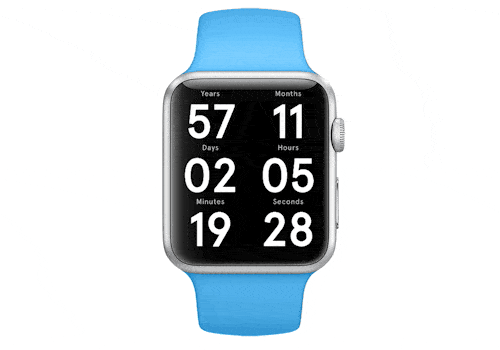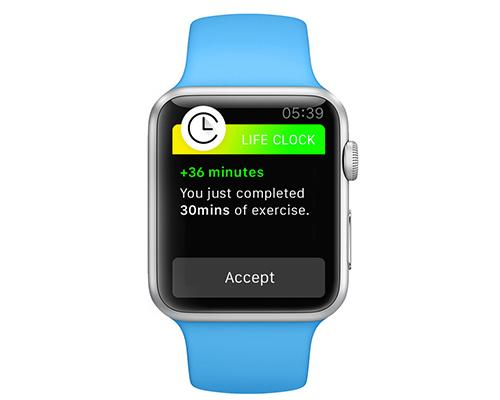 |
| Apple watch |
The Apple Watch Face That Counts Down to Your Death Kyle Vanhemert, Wired March 17, 2015 The Apple Watch Face That Counts Down to Your Death Here’s one way the Apple Watch could help you live a fuller life: by counting down the seconds until you die. While Tim Cook was showing off the foot-tapping Mickey Mouse watch face at Apple’s recent event, digital design group Rehabstudio was fleshing out its own vision of time-keeping on the device. The app, Life Clock, estimates how much time you have left on this rock, adding minutes for healthful activity and subtracting them when you indulge in bad habits. You can think of it as a mortality forecaster, or an activity tracker in reverse—instead of tabulating what you did in the past, it extrapolates what your behavior means for your future. More broadly, it’s a reminder that there are a great many ways to represent time, and with a powerful, sensor-laden wrist computer, it’s worth exploring them. Playing With Time Timekeeping is one of the tent pole features of the Apple Watch. Jony Ive has bragged about how deeply his team researched the history of horology while developing the device. Apple says there will be nine official faces available when the watch launches next month. They’ll be customizable to a remarkable degree, at least by Apple standards, allowing users to add and subtract detail. On some faces, watch owners will be able to arrange widgets for things like weather, activity, and moon phase. Five of the designs are analog, four are digital, but none are especially radical in the way they approach time. READ: Can You Hypnotize a Shark? Rehabstudio, which does fancy digital marketing work for clients like Red Bull and Ace Hotel, started pondering the concept of time about the time the Apple Watch was unveiled last fall. “We saw an opportunity,” says partner Tom Le Bree. “We thought, ‘OK, if time is really a human construct, how can we play with it?’” image That question got Le Bree thinking about a discussion he’d had with a professor from the University of Warwick, one of Europe’s leading schools for behavioral economics. Specifically, a concept called temporal discounting. “In essence, the idea is we discount the future in favor of the present,” Le Bree says. “Tomorrow, I’m the guy that goes to the gym, quits smoking, and stops eating fatty foods. But today I’m going to have one last cigarette.” That concept became the kernel for Life Clock. The basic idea: By reminding us of the future, a watch face could help us make healthier decisions in the present. Rehabstudio fleshed out the concept over the course of a week at a company hackathon, using life expectancy data from a handful of sources. It’s an imprecise science, Le Bree admits, though that’s sort of beside the point. If it helps stave off that cigarette, it’s working. READ: Fat? Sick? Blame Your Grandparents’ Bad Habits But don’t start counting down the days until you can start counting down your days just yet. Apple hasn’t yet said if it will allow owners to use third party faces with the watch. There’s no mention of them in the developer tools Apple’s released for the device. For now, Rehabstudio plans to continue working on the project, and it’s considering a version for Android Wear, but it’s possible Apple’s rules could preclude the vision in its original form. Life Clock could exist as an app, but it wouldn’t be the same. Your mortality isn’t quite as powerful when it’s just another icon on your home screen. Other Alternatives Still, Life Clock is compelling if only as a concept. It challenges us to rethink what it means to interact with time. And it’s just one possibility for how we might reframe time on these sorts of devices. Pebble’s new watch software recasts time as an interaction metaphor, using it to organize functionality throughout the day. Le Bree points to Slow Watches, a company that makes time pieces with only an hour hand, encouraging a less hurried relationship with time. Durr, a wearable made by a pair of designers from Norway, doesn’t really have a face at all. Instead, its just a colorful plastic disc that vibrates every five minutes—a haptic metronome designed to highlight the disconnect between time as it passes on a clock and time as you actually perceive it. READ: An Online Game That’ll Help You Pay Off Your Student Debt With smart watches, there’s no reason we shouldn’t dabble with these sorts of alternatives. Time, after all, is a singular resource. “It’s one of the few things you can’t purchase and can’t get back,” Le Bree says. “It’s the same for everybody. And we’ve only scratched the surface of how you can use it as a motivator.” image More from Wired * Hunters Find a Frozen 10,000-Year-Old Baby Woolly Rhino * 12 Tales of Getting It On In the Digital Age * This Hellish Underground Fire Has Burned for 100 Years
